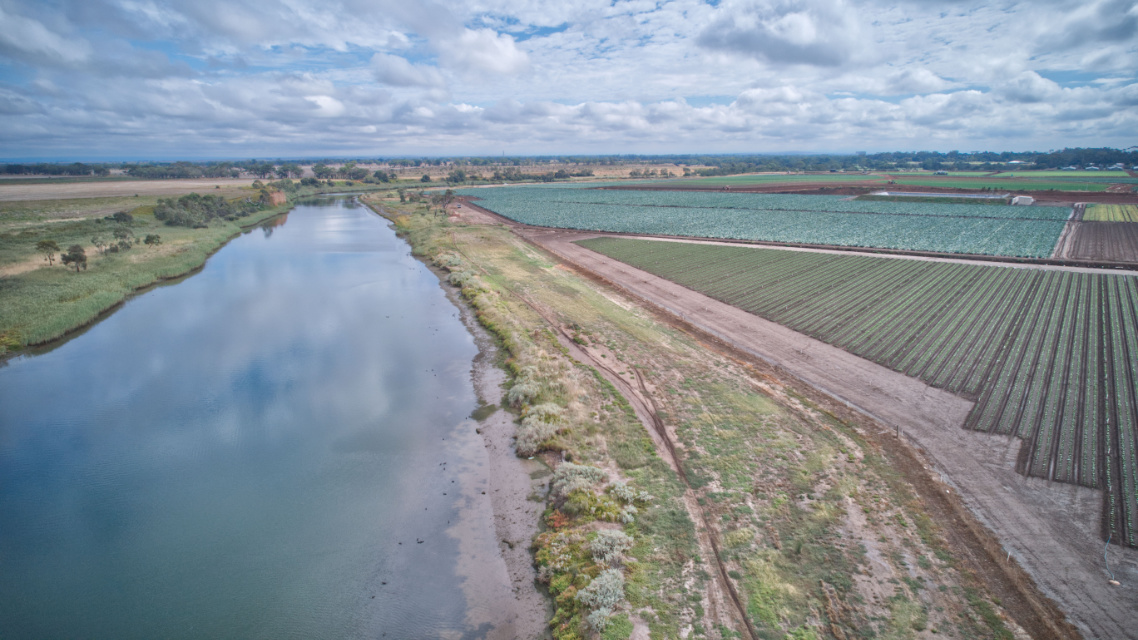
Saving Our Soils Project
Monitoring water quality in the Werribee River
Background
The Saving Our Soils Project is an initiative through the Werribee River Association which aims to increase the efficiency of the market gardens, while improving river and waterway health. Soil can run off farms due to excessive irrigation and rain, taking with it sediment, pesticides and nutrients. Not only is this inefficient for farmers who have to keep replacing what is gone, but the runoff into the river effects the health of our waterways. The Werribee River Association engaged Bio2lab to install two real-time water quality monitoring stations along Werribee River at strategic locations as a way to assess the impact of this runoff continuously over the next two years. As part of the broader project, revegetation of areas prone to erosion will attempt to slow the movement of run-off and reduce sediment and associated pollutants from entering the Werribee River. The sensors will allow the Association to assess the success of the revegetation projects over the longer term by monitoring turbidity (an indicator of soil runoff).
Project update
Real-time water quality sensors were installed in the Werribee River, both upstream and downstream of the areas being revegetated along the river’s edge. Monitoring commenced on 2nd September 2023, which was delayed due to on-going local grower engagement and changes in the design of the monitoring program to better suit the on-ground revegetation work.
Monitoring continues, with data logged every 15 minutes and updated daily. The data displayed on the dashboard below plots a daily average for both locations. Water quality parameters include turbidity, electrical conductivity and temperature.
The interactive app below provides a real-time daily update of the logger data. Hovering over the data will allow you to interact with the plots, displaying water quality values. By selecting date ranges using the buttons, you can interrogate data collected over time in more detail, while drawing a box over the data will allow you to select custom time periods. In the top right hand corner of each plot, there is a menu that will allow you to navigate the data in more detail. If the dashboard disconnects after being idle for a period of time, please reconnect using the reload button at the bottom of the dashboard. Gaps in the data may indicate that the sensor is out of range. For instance, if the water level drops to below the sensor sonde due to low water level in the river, readings will drop to zero. As part of the data cleaning process, these readings would be excluded from the datasets.
Water quality monitoring
Water quality varies between the upstream and downstream site. In general, there seems to have been a slight reversal from higher turbidity levels at the downstream compared to the upstream site, to lower turbidity at the downstream site compared to the upstream site since December 2023. While it is early in the project, these results indicate that on-ground changes may be contributing to less soil erosion from the catchment downstream of the upstream station. What impact the riparian plantings conducted by the Werribee River Association are having on these results still requires more research.
The first 9-10 months of water quality monitoring has allowed the Werribee River Association to better understand the maintenance requirements of the monitoring stations. For instance, it become evident that a regular cleaning regime was required to keep the sensors performing as expected. This was because biofilm ((often microorganisms in the water that adhere to surfaces such as sensors), can often interfere with the function of sensors, especially turbidity, which uses light as an indicator of turbidity levels. And while the sensors installed in this project have been designed to cope with some levels of biofilm build up, regular cleaning of the sensors will keep the readings more accurate and extend the life of the sensors themselves.
Summary
Results from the water quality monitoring program so far indicates that there may have been a slight reversal from higher turbidity levels at the downstream compared to the upstream site since December 2023. The reasons for the decreasing turbidity levels at the downstream site compared to the upstream site remain somewhat unclear, and more on-going research is required.
However, in general the results show that either the increase in riparian vegetation or changes in on-ground management are potentially having positive outcomes on water quality in the Werribee River. It is anticipated that as more water quality data is collected from the real-time sensors, a clearer picture of soil erosion from market gardens in Werribee South will emerge. As plantings along the river’s edge take hold, we should expect to see similar differences in turbidity levels between the two sites.
Any increase in riparian vegetation along the edges of the Werribee River will likely slow the movement of soils off the market gardens and will clean the water through natural filtration processes before entering the river.

